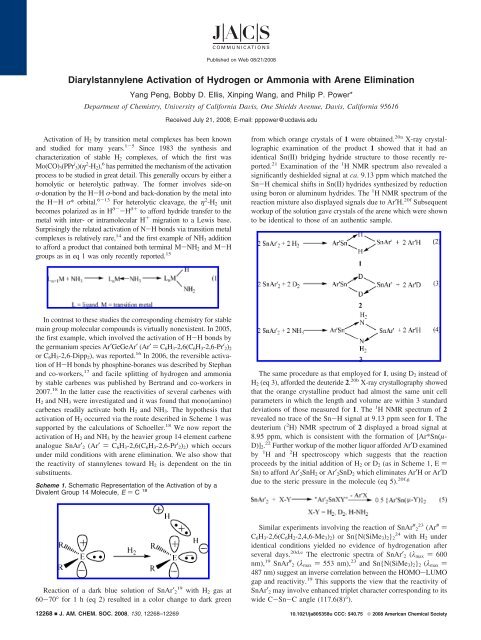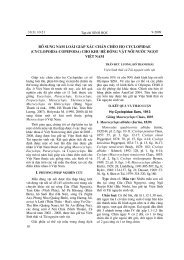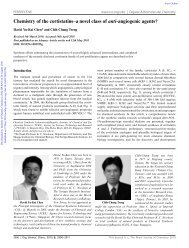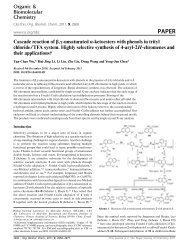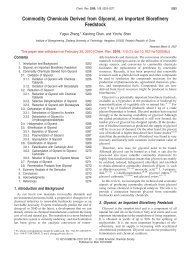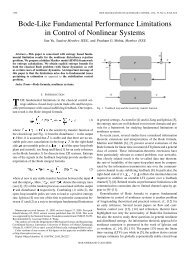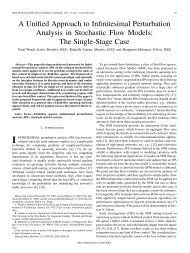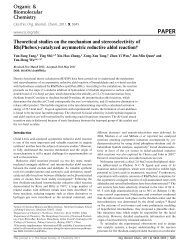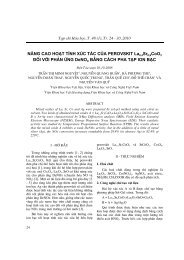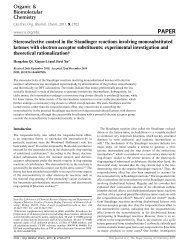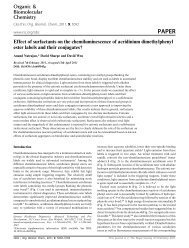Diarylstannylene Activation of Hydrogen or Ammonia with Arene Elimination
Diarylstannylene Activation of Hydrogen or Ammonia with Arene Elimination
Diarylstannylene Activation of Hydrogen or Ammonia with Arene Elimination
You also want an ePaper? Increase the reach of your titles
YUMPU automatically turns print PDFs into web optimized ePapers that Google loves.
<strong>Diarylstannylene</strong> <strong>Activation</strong> <strong>of</strong> <strong>Hydrogen</strong> <strong>or</strong> <strong>Ammonia</strong> <strong>with</strong> <strong>Arene</strong> <strong>Elimination</strong><br />
Yang Peng, Bobby D. Ellis, Xinping Wang, and Philip P. Power*<br />
Department <strong>of</strong> Chemistry, UniVersity <strong>of</strong> Calif<strong>or</strong>nia DaVis, One Shields AVenue, DaVis, Calif<strong>or</strong>nia 95616<br />
<strong>Activation</strong> <strong>of</strong> H2 by transition metal complexes has been known<br />
and studied f<strong>or</strong> many years. 1-5 Since 1983 the synthesis and<br />
characterization <strong>of</strong> stable H2 complexes, <strong>of</strong> which the first was<br />
Mo(CO)3(PPr i 3)(η 2 -H2), 6 has permitted the mechanism <strong>of</strong> the activation<br />
process to be studied in great detail. This generally occurs by either a<br />
homolytic <strong>or</strong> heterolytic pathway. The f<strong>or</strong>mer involves side-on<br />
σ-donation by the H-H σ-bond and back-donation by the metal into<br />
the H-H σ* <strong>or</strong>bital. 6-13 F<strong>or</strong> heterolytic cleavage, the η 2 -H2 unit<br />
becomes polarized as in H δ- -H δ+ to aff<strong>or</strong>d hydride transfer to the<br />
metal <strong>with</strong> inter- <strong>or</strong> intramolecular H + migration to a Lewis base.<br />
Surprisingly the related activation <strong>of</strong> N-H bonds via transition metal<br />
complexes is relatively rare, 14 and the first example <strong>of</strong> NH3 addition<br />
to aff<strong>or</strong>d a product that contained both terminal M-NH2 and M-H<br />
groups as in eq 1 was only recently rep<strong>or</strong>ted. 15<br />
In contrast to these studies the c<strong>or</strong>responding chemistry f<strong>or</strong> stable<br />
main group molecular compounds is virtually nonexistent. In 2005,<br />
the first example, which involved the activation <strong>of</strong> H-H bonds by<br />
the germanium species Ar′GeGeAr′ (Ar′ ) C6H3-2,6(C6H3-2,6-Pr i 2)2<br />
<strong>or</strong> C6H3-2,6-Dipp2), was rep<strong>or</strong>ted. 16 In 2006, the reversible activation<br />
<strong>of</strong> H-H bonds by phosphine-b<strong>or</strong>anes was described by Stephan<br />
and co-w<strong>or</strong>kers, 17 and facile splitting <strong>of</strong> hydrogen and ammonia<br />
by stable carbenes was published by Bertrand and co-w<strong>or</strong>kers in<br />
2007. 18 In the latter case the reactivities <strong>of</strong> several carbenes <strong>with</strong><br />
H2 and NH3 were investigated and it was found that mono(amino)<br />
carbenes readily activate both H2 and NH3. The hypothesis that<br />
activation <strong>of</strong> H2 occurred via the route described in Scheme 1 was<br />
supp<strong>or</strong>ted by the calculations <strong>of</strong> Schoeller. 18 We now rep<strong>or</strong>t the<br />
activation <strong>of</strong> H2 and NH3 by the heavier group 14 element carbene<br />
analogue SnAr′2 (Ar′ ) C6H3-2,6(C6H3-2,6-Pr i 2)2) which occurs<br />
under mild conditions <strong>with</strong> arene elimination. We also show that<br />
the reactivity <strong>of</strong> stannylenes toward H2 is dependent on the tin<br />
substituents.<br />
Scheme 1. Schematic Representation <strong>of</strong> the <strong>Activation</strong> <strong>of</strong> by a<br />
Divalent Group 14 Molecule, E ) C 18<br />
Reaction <strong>of</strong> a dark blue solution <strong>of</strong> SnAr′2 19 <strong>with</strong> H2 gas at<br />
60-70° f<strong>or</strong> 1 h (eq 2) resulted in a col<strong>or</strong> change to dark green<br />
12268 9 J. AM. CHEM. SOC. 2008, 130, 12268–12269<br />
Published on Web 08/21/2008<br />
Received July 21, 2008; E-mail: pppower@ucdavis.edu<br />
from which <strong>or</strong>ange crystals <strong>of</strong> 1 were obtained. 20a X-ray crystallographic<br />
examination <strong>of</strong> the product 1 showed that it had an<br />
identical Sn(II) bridging hydride structure to those recently rep<strong>or</strong>ted.<br />
21 Examination <strong>of</strong> the 1 H NMR spectrum also revealed a<br />
significantly deshielded signal at ca. 9.13 ppm which matched the<br />
Sn-H chemical shifts in Sn(II) hydrides synthesized by reduction<br />
using b<strong>or</strong>on <strong>or</strong> aluminum hydrides. The 1 H NMR spectrum <strong>of</strong> the<br />
reaction mixture also displayed signals due to Ar′H. 20f Subsequent<br />
w<strong>or</strong>kup <strong>of</strong> the solution gave crystals <strong>of</strong> the arene which were shown<br />
to be identical to those <strong>of</strong> an authentic sample.<br />
The same procedure as that employed f<strong>or</strong> 1, using D2 instead <strong>of</strong><br />
H2 (eq 3), aff<strong>or</strong>ded the deuteride 2. 20b X-ray crystallography showed<br />
that the <strong>or</strong>ange crystalline product had almost the same unit cell<br />
parameters in which the length and volume are <strong>with</strong>in 3 standard<br />
deviations <strong>of</strong> those measured f<strong>or</strong> 1. The 1 H NMR spectrum <strong>of</strong> 2<br />
revealed no trace <strong>of</strong> the Sn-H signal at 9.13 ppm seen f<strong>or</strong> 1. The<br />
deuterium ( 2 H) NMR spectrum <strong>of</strong> 2 displayed a broad signal at<br />
8.95 ppm, which is consistent <strong>with</strong> the f<strong>or</strong>mation <strong>of</strong> [Ar*Sn(µ-<br />
D)]2. 22 Further w<strong>or</strong>kup <strong>of</strong> the mother liqu<strong>or</strong> aff<strong>or</strong>ded Ar′D examined<br />
by 1 H and 2 H spectroscopy which suggests that the reaction<br />
proceeds by the initial addition <strong>of</strong> H2 <strong>or</strong> D2 (as in Scheme 1, E )<br />
Sn) to aff<strong>or</strong>d Ar′2SnH2 <strong>or</strong> Ar′2SnD2 which eliminates Ar′H<strong>or</strong>Ar′D<br />
due to the steric pressure in the molecule (eq 5). 20f,g<br />
Similar experiments involving the reaction <strong>of</strong> SnAr # 2 23 (Ar # )<br />
C6H3-2,6(C6H2-2,4,6-Me3)2) <strong>or</strong> Sn{N(SiMe3)2}2 24 <strong>with</strong> H2 under<br />
identical conditions yielded no evidence <strong>of</strong> hydrogenation after<br />
several days. 20d,e The electronic spectra <strong>of</strong> SnAr′2 (λmax ) 600<br />
nm), 19 SnAr # 2 (λmax ) 553 nm), 23 and Sn{N(SiMe3)2}2 (λmax )<br />
487 nm) suggest an inverse c<strong>or</strong>relation between the HOMO-LUMO<br />
gap and reactivity. 19 This supp<strong>or</strong>ts the view that the reactivity <strong>of</strong><br />
SnAr′2 may involve enhanced triplet character c<strong>or</strong>responding to its<br />
wide C-Sn-C angle (117.6(8)°).<br />
10.1021/ja805358u CCC: $40.75 © 2008 American Chemical Society
Figure 1. Thermal ellipsoid (30%) drawing <strong>of</strong> 3. <strong>Hydrogen</strong> atoms, except<br />
those at nitrogen, are not shown f<strong>or</strong> clarity.<br />
The addition <strong>of</strong> an excess <strong>of</strong> dry ammonia to a dark blue solution<br />
<strong>of</strong> SnAr′2 in toluene rapidly discharged the col<strong>or</strong>. Concentration <strong>of</strong><br />
the solution produced col<strong>or</strong>less crystals <strong>of</strong> the new species 3 (eq 4). 20c<br />
X-ray crystallography 25 aff<strong>or</strong>ded a dimeric structure as illustrated in<br />
Figure 1. The tin centers were symmetrically bridged by the NH2<br />
ligands in which the two hydrogens were located in the electron density<br />
map. The rhombohedral Sn2N2 c<strong>or</strong>e is planar <strong>with</strong> the angles NSnN<br />
) 76.38(5)° and SnNSn ) 103.62(5)°. The tins have terminally bound<br />
Ar′ ligands which yield trigonal pyramidal co<strong>or</strong>dination as shown by<br />
the sum <strong>of</strong> the angles at tin <strong>of</strong> 266.16°. The Sn-N bridging distances<br />
(2.1913(13) and 2.1918(13) Å) are in good agreement <strong>with</strong> the rep<strong>or</strong>ted<br />
Sn-N distance 2.21 Å in {Ar*Sn(µ-NH2)}2 (Ar* ) C6H3-2,6(C6H2-<br />
2,4,6-Pr i 3)2) 26 which differs from 3 in that it has a bulkier terphenyl<br />
ligand. The IR spectrum displayed two weak sharp bands at 3357 and<br />
3260 cm -1 that are due to the two N-H stretching modes <strong>of</strong> the -NH2<br />
groups. These frequencies are close to those at 3370 and 3290 cm -1<br />
observed f<strong>or</strong> [Ar*Sn(µ-NH2)]2. 26 The reaction probably proceeds in<br />
the same manner as that described in eq 5 to generate an Ar′2Sn(H)NH2<br />
intermediate which eliminates Ar′H to aff<strong>or</strong>d 3.<br />
In summary we have shown that the stannylenene SnAr′2 19 reacts<br />
<strong>with</strong> H2 <strong>or</strong> NH3 to aff<strong>or</strong>d the products 1 <strong>or</strong> 3. The c<strong>or</strong>responding<br />
lack <strong>of</strong> reactivity <strong>of</strong> H2 toward SnAr # 2 <strong>or</strong> Sn{N(SiMe3)2}2 suggests<br />
that the ability <strong>of</strong> SnAr′2 to activate H2 may be associated <strong>with</strong><br />
increased triplet character in its ground state. The reaction differs<br />
from that <strong>of</strong> carbenes in that an arene is eliminated. However the<br />
initial step probably proceeds acc<strong>or</strong>ding to Scheme 1 (E ) Sn).<br />
Acknowledgment. We thank the U.S. Department <strong>of</strong> Energy<br />
Office <strong>of</strong> Basic Energy Sciences DE-FG02-07ER46475 f<strong>or</strong> financial<br />
supp<strong>or</strong>t. B.D.E. thanks the NSERC <strong>of</strong> Canada f<strong>or</strong> a postdoct<strong>or</strong>al<br />
fellowship. We thank Dr. Jeff De Ropp and Pr<strong>of</strong>. R. A. Andersen<br />
f<strong>or</strong> helpful discussions.<br />
Supp<strong>or</strong>ting Inf<strong>or</strong>mation Available: Crystallographic data f<strong>or</strong> 3<br />
(CIF), unit cell parameters f<strong>or</strong> 1 and 2. This material is available free<br />
<strong>of</strong> charge via the Internet at http://pubs.acs.<strong>or</strong>g.<br />
References<br />
(1) Halpern, J. AdV. In<strong>or</strong>g. Chem. 1956, 11, 301.<br />
(2) Brothers, P. J. Prog. In<strong>or</strong>g. Chem. 1981, 28, 1.<br />
(3) James, B. R. Homogenous <strong>Hydrogen</strong>ation, Wiley, New Y<strong>or</strong>k, 1973.<br />
(4) Kubas, G. J. AdV. In<strong>or</strong>g. Chem. 2001, 56, 127.<br />
(5) Osb<strong>or</strong>n, J.; Jardine, F. H.; Young, J. F.; Wilkinson, G. J. Chem. Soc. A<br />
1966, 1711.<br />
(6) Kubas, G. J.; Ryan, R. R.; Swanson, B. L.; Vergamini, P. J.; Wasserman,<br />
H. J. Am. Chem. Soc. 1984, 106, 451.<br />
(7) Kubas, G. J. Metal Dihydrogen and σ-Bond Complexes; Kluwer: New Y<strong>or</strong>k,<br />
2001.<br />
(8) Crabtree, R. H. Acc. Chem. Res. 1990, 23, 95.<br />
(9) Jessop, P. G.; M<strong>or</strong>ris, R. H. Co<strong>or</strong>d. Chem. ReV. 1982, 121, 155.<br />
(10) Heinekey, D. M.; Oldham, W. J. Chem. ReV. 1993, 93, 913.<br />
(11) Crabtree, R. H. In Modern Co<strong>or</strong>dination Chemistry: The Legacy <strong>of</strong> Joseph<br />
Chatt; Leigh, G. J., Winterton, N., Eds.; Royal Society <strong>of</strong> Chemistry:<br />
Cambridge, 2002; p 31.<br />
(12) Clapham, S. E.; Hadzovic, A.; M<strong>or</strong>ris, R. H. Co<strong>or</strong>d. Chem. ReV. 2004,<br />
248, 2201.<br />
(13) Heinekey, D. M.; Lledas, A.; Lluch, J. M. Chem. Soc. ReV. 2004, 33, 175.<br />
(14) Casalnuovo, A. L.; Calabrese, J. C.; Milstein, D. In<strong>or</strong>g. Chem. 1987, 26,<br />
971.<br />
(15) Zhao, J.; Goldman, A. S.; Hartwig, J. S. Science 2005, 307, 1080.<br />
(16) Spikes, G. H.; Fettinger, J. C.; Power, P. P. J. Am. Chem. Soc. 2005, 127,<br />
12232.<br />
(17) Welch, G. C.; San Juan, R. R.; Masuda, J. D.; Stephan, D. W. Science<br />
2006, 314, 1124.<br />
(18) Frey, G. D.; Lavallo, V.; Donnadieu, B.; Schoeller, W. W.; Bertrand, G.<br />
Science 2007, 316, 439.<br />
(19) Spikes, G. H.; Peng, Y.; Fettinger, J. C.; Power, P. P. Z. An<strong>or</strong>g. Allg. Chem.<br />
2006, 632, 1005.<br />
(20) All manipulations were carried out under anaerobic and anhydrous<br />
conditions. (a) 1. [Ar′Sn(µ-H)]2: A solution <strong>of</strong> SnAr′2 (1.15 g, 1.26 mmol)<br />
in toluene (50 mL) was stirred at 65° f<strong>or</strong> 2 h under a H2 atmosphere to<br />
give a dark green solution. The mixture was concentrated to ca. 10 mL<br />
under vacuum which aff<strong>or</strong>ded <strong>or</strong>ange crystals <strong>of</strong> 1 upon cooling to ca.-<br />
16°C. Yield: 39%. 1 H NMR (C6D6): 0.93 (d, 6H, 3 JHH ) 6.6 Hz, CH(CH3)2,<br />
1.02 (d, 6H, 3 JHH ) 6.6 Hz, CH(CH3)2, 1.04 (d, 6H, 3 JHH ) 6.6 Hz,<br />
CH(CH3)2, 1.11 (d, 6H, 3 JHH ) 6.6 Hz, CH(CH3)2), 3.00 (overlap septets,<br />
4H, CH(CH3)2), 7.03 (d, 4H, 3 JHH ) 7.5 Hz, m-DippH), 7.10 (m, overlap<br />
ArH), 7.30 (t, 2H, 3 JHH ) 7.5 Hz, p-DippH), 9.13 (s, 1H, 1 JSn-H ) ca. 89<br />
Hz, Sn-H). 119 Sn{ 1 H} NMR: δ 657. (b) 2. [Ar′Sn(µ-D)]2: A solution <strong>of</strong><br />
SnAr′2 (1.05 g, 1.15 mmol) in toluene (50 mL) was stirred at 65 °C f<strong>or</strong>2h<br />
under a D2 atmosphere to give a dark green solution. The mixture was<br />
concentrated to ca. 10 mL under vacuum which aff<strong>or</strong>ded <strong>or</strong>ange crystals<br />
<strong>of</strong> 2 upon cooling to ca.-16 °C. Yield: 45%. 1 H NMR (C6D6): 0.93 (d,<br />
6H, 3 JHH ) 6.6 Hz, CH(CH3)2, 1.02 (d, 6H, 3 JHH ) 6.6 Hz, CH(CH3)2),<br />
1.04 (d, 6H, 3 JHH ) 6.6 Hz, CH(CH3)2), 1.11 (d, 6H, 3 JHH ) 6.6 Hz,<br />
CH(CH3)2), 3.00 (overlap septets, 4H, CH(CH3)2), 7.03 (d, 4H, 3 JHH ) 7.5<br />
Hz, m-DippH 7.10-7.28 (m, overlap ArH),) 2 H NMR (C7H8): 8.98 (s, 1D).<br />
119 Sn{ 1 H} NMR (C7D8): δ 610. (c) 3. [Ar′Sn(µ-NH2)]2: To a deep blue<br />
solution <strong>of</strong> SnAr′2 (0.45g, 0.5 mmol) in toluene (50 mL) at-78° was added<br />
several drops <strong>of</strong> liquid ammonia. The solution became light yellow.<br />
Warming to room temperature produced a col<strong>or</strong>less solution, which was<br />
concentrated to ca. 30 mL under reduced pressure to give col<strong>or</strong>less crystals<br />
that were identified as 3 on the basis <strong>of</strong> NMR spectroscopy and X-ray<br />
crystallography. Yield: 55%. Mp: 120-125°. 1 H NMR (C7D8): δ 0.72 (s,<br />
2H, NH2), 1.48 (d, 12H, 3 JHH ) 6.6 Hz, CH(CH3)2), 1.63 (d, 12H, 3 JHH )<br />
6.6 Hz, CH(CH3)2), 3.42 (septets, 4H, CH(CH3)2), 7.48 (t, 2H, 3 JHH ) 6.6<br />
Hz, p-DippH), 7.58 (t, 1H, 3 JHH ) 6.6 Hz, p-C6H3), 7.65 (d, 4H, 3 JHH )<br />
6.6 Hz, m-Dipp)), 7.68 (d, 2H, 3 JHH )7.5 Hz, m-C6H3). 13 C{ 1 H}<br />
NMR(C7D8): 24.31 (CH(CH3)2), 26.55 (CH(CH3)2), 31.22 (CH(CH3)2),<br />
126.45 (p-C6H3), 128.91 (p-Dipp), 129.54 (i-Dipp), 130.24 (m-C6H3), 138.17<br />
(i-Dipp), 147.15 (o-C6H3), 157.42 (i-C6H3). 119 Sn{ 1 H} NMR (C7D8): δ<br />
280.26. IR (Nujol): ν 3357, 3260 cm -1 (ν NH2, weak). (d) 4. SnAr # 2:A<br />
purple solution <strong>of</strong> SnAr # 2 (0.75 g, 1 mmol) in toluene (50 mL) was stirred<br />
at 70° f<strong>or</strong> 6 days under a H2 atmosphere. No col<strong>or</strong> change was observed.<br />
The solvent was pumped <strong>of</strong>f, and 1 H and 119 Sn NMR spectroscopy showed<br />
that it was the reactant SnAr # 2. Recovered yield >80%. 1 H NMR (C6D6):<br />
1.90 (s, 12H, o-CH3), 2.21 (s, 6H, p-CH3), 6.77 (s, 4H, m-Mes), 6.80 (d,<br />
2H, JHH ) 7.5 Hz, m-C6H3), 7.12 (t, 1H, JHH ) 7.8 Hz, p-C6H3). 119 Sn<br />
{ 1 H} NMR: δ 635. 23. (e) 5. Sn{N(SiMe3)2}2: An <strong>or</strong>ange solution <strong>of</strong><br />
Sn{N(SiMe3)2}2 (1.09 g, 2.5 mmol) in toluene (50 mL) was stirred at 70°<br />
f<strong>or</strong> 3 days under a H2 atmosphere. No col<strong>or</strong> change was observed. The<br />
solvent was pumped <strong>of</strong>f, and 1 H, 119 Sn NMR spectroscopy indicated<br />
unchanged Sn{N(SiMe3)2}2. Recovered yield >85%. 1 H NMR (C6D6): 0.28<br />
(s, 18H, -CH3). 119 Sn{ 1 H} NMR: δ 767. 27a,b (f) Ar′H (from mother liqu<strong>or</strong>):<br />
1 H NMR (C6D6): δ 1.11 (d, 6H, 3 JHH ) 6.6 Hz, CH(CH3)2), 1.14 (d, 6H,<br />
3 JHH ) 6.6 Hz, CH(CH3)2), 2.90 (septets, 4H, CH(CH3)2), 6.89 (s, i-C6H3),<br />
7.04 (s, i-Dipp), 7.09 (d, 4H, m-C6H3), 7.10 (d, 4H, 3 JHH ) 6.6 Hz,<br />
m-Dipp)), 7.22 (t, 1H, 3 JHH ) 7.5 Hz, p-C6H3), 7.31 (t, 4H, 3 JHH ) 6.6 Hz,<br />
p-Dipp). (g) Ar′D (mother liqu<strong>or</strong>): 1 H NMR (C6D6): δ 1.11 (d, 6H, 3 JHH )<br />
6.6 Hz, CH(CH3)2), 1.14 (d, 6H, 3 JHH ) 6.6 Hz, CH(CH3)2), 2.89 (septets,<br />
4H, CH(CH3)2), 7.04 (s, i-Dipp), 7.09 (d, 4H, m-C6H3), 7.10 (d, 4H, 3 JHH<br />
) 6.6 Hz, m-Dipp)), 7.22 (t, 1H, 3 JHH ) 7.5 Hz, p-C6H3), 7.31 (t, 4H, 3 JHH<br />
) 6.6 Hz, p-Dipp). 2 H NMR (C6H14): 6.98 (s, i-C6H3).<br />
(21) Rivard, E.; Fischer, R. C.; Wolf, R.; Peng, Y.; Merrill, W. A.; Schley,<br />
N. D.; Zhu, Z.; Pu, L.; Fettinger, J. C.; Teat, S. J.; Nowik, I.; Herber, R. H.;<br />
Takagi, N.; Nagase, S.; Power, P. P. J. Am. Chem. Soc. 2007, 129, 16197.<br />
(22) Eichler, B. E.; Power, P. P. J. Am. Chem. Soc. 2000, 122, 8785.<br />
(23) Simons, R. S.; Pu, L.; Olmstead, M. M.; Power, P. P. Organometallics<br />
1997, 16, 1920.<br />
(24) Fjelberg, T.; Hope, H.; Lappert, M. F.; Power, P. P.; Th<strong>or</strong>ne, A. J. J. Chem.<br />
Soc., Chem. Commun. 1983, 639.<br />
(25) Crystal Data f<strong>or</strong> 3 · 4PhMe 90(2) K <strong>with</strong> Mo KR (λ ) 0.710 73 Å), fw )<br />
1433.20, triclinic, P1j, col<strong>or</strong>less block, a ) 12.0051(6) Å, b ) 13.3719(7)<br />
Å, c ) 13.6933(7) Å, R ) 110.5722(7)°, ) 102.3158(7)°, γ )<br />
103.5991(7)°, V ) 1891.60(17) Å 3 , Z ) 1, 21 146 total reflections, 8667[I<br />
> 2σ(I)] R1 ) 0.0220, wR2 ) 0.0552, R indices (all data) R1 ) 0.0268,<br />
wR2 ) 0.0578.<br />
(26) Stanciu, C.; Hino, S.; Stender, M.; Richards, A. F.; Olmstead, M. M.; Power,<br />
P. P. In<strong>or</strong>g. Chem. 2005, 44, 2774.<br />
(27) (a) Wrackmeyer, B. In UnkonVentionelle Wechselwirkungen in der Chemie<br />
metallischer Elemente; Krebs, B., Ed.; VCH: Weinheim, 1992; pp 111-<br />
124. (b) Wrackemeyer, B. Ann. Rep. NMR Spectrosc. 1999, 38, 20.<br />
JA805358U<br />
COMMUNICATIONS<br />
J. AM. CHEM. SOC. 9 VOL. 130, NO. 37, 2008 12269


